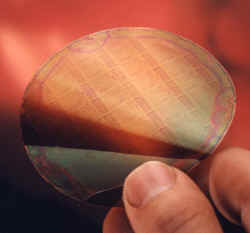Nobel Focus: Electricity through Plastic

The chemistry Nobel Prize this year went to Alan Heeger, Alan MacDiarmid, and Hideki Shirakawa “for the discovery and development of electrically conductive polymers.” The laureates first described the details of their discovery in PRL in 1977, 23 year ago today. At the time, plastics were considered nonconductors, but the team showed that adding some impurities to a polymer material could increase its conductivity by more than a billion times. Their work led to the field of plastic electronics, which has resulted in several commercial applications. But they also helped to spur new areas of fundamental research in condensed matter physics by demonstrating some exotic polymer properties, such as charge carriers that, unlike electrons, have zero spin.
Plastics are so dependable as insulators (materials that don’t conduct electricity) that they are often used for the protective coatings around wires. By the 1970s chemists had worked with some small organic molecules that could conduct, but a conducting, carbon-based, long-chain molecule was something “no one had really contemplated,” recalls Richard Friend of the University of Cambridge in the UK. Polymers were known to be far cheaper to process than conventional electronics materials, which is one reason the results had “a huge impact,” says Friend.
Heeger, MacDiarmid, and Shirakawa, then at the University of Pennsylvania, worked with polyacetylene, which consists of a long chain of carbon atoms, each bound to two neighboring carbons and a single hydrogen atom. The carbon-carbon bonds are not identical, but alternate between single and double bonds. Normally the electrons in the bonds remain localized and cannot carry an electric current, but when the team “doped” the material with strong electron acceptors such as iodine, the polymer began to conduct nearly as well as a metal, with a conductivity 1010 times higher than pure polyacetylene. They confirmed that the polymer had become metallic by showing that doping caused it to absorb and reflect far infrared light, whereas the pure polymer is transparent. Photons in that range allow polyacetylene’s electrons to absorb energy and enter the so-called conduction band.
Heeger recalls that, while the team was aware of possible commercial applications for the new class of conducting polymers, their research in the following years was always motivated by fundamental physics questions. For example, how does polyacetylene become a conductor? Later work showed that polyacetylene and related materials behave quite differently from traditional semiconductors and conductors. For one thing, at intermediate doping levels, current is carried not by “delocalized,” nearly free electrons, as in silicon or copper, but by the electrons in the carbon-carbon bonds. When a dopant removes an electron from the molecule, it can turn a double bond into a one-electron single bond, forcing a carbon atom to make single bonds with both of its neighboring carbons. That charged “defect,” called a polaron, can travel down the molecule as each successive carbon atom grabs an electron from its neighbor, trying to compensate for the change. Since single and double bonds have different lengths, the movement of charge is intimately connected with stresses and strains among the carbon atoms themselves, not just their electrons.
Polarons and other polymer chain defects called solitons turned out to have unexpected properties, such as spin in the absence of charge or charge in the absence of spin. The separation of spin and charge in one-dimensional systems remains an active area of condensed matter research today and is thought by some to be relevant to high temperature superconductors.
Heeger, a physicist, is proud to have helped lay the groundwork for the field of semiconducting and metallic polymers, and to have received the chemistry Nobel Prize. “Blurring these traditional academic distinctions is a good thing,” he says. Heeger calls the world between academic departments “the place to be.”
More Information
The Nobel Foundation, including information on laureates and their work.


